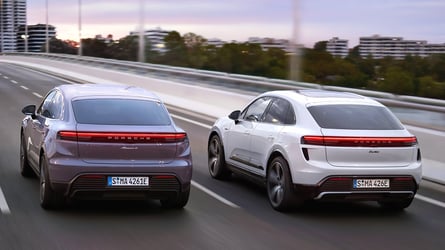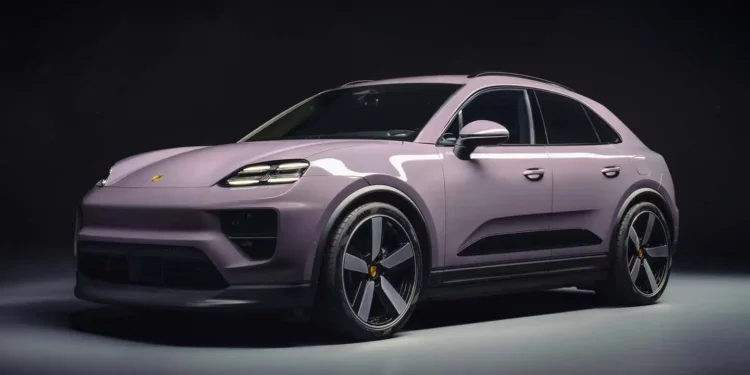Porsche has recently introduced its second all-electric model: the Macan Electric, which will enter the U.S. market during the second half of 2024.
The compact SUV will be noticeably less expensive than the Porsche Taycan and just as practical in everyday use. We expect sales of the Macan Electric to be an order of magnitude higher than the Taycan, which notched 40,629 global sales last year.






Pricing
The first two versions of the electrified Porsche Macan are the Macan 4 Electric and Macan Turbo Electric. Both are equipped with the same 100-kWh battery and a dual-motor, all-wheel-drive powertrain.
The entry-level Porsche Macan 4 Electric has an MSRP of $78,800 (plus a $1,650 destination charge).
If you want the faster model, you need to spend an extra $26,500 for the Porsche Macan Turbo Electric, which starts at $105,300.
| Model | Base Price | Dest. Charge | Tax Credit | Effective Price |
| 2024 Porsche Macan 4 Electric 20-inch | $78,800 | +$1,650 | N/A | $80,450 |
| 2024 Porsche Macan Turbo Electric 20-inch | $105,300 | +$1,650 | N/A | $106,950 |
The Porsche Macan is produced at the Porsche Plant Leipzig in Germany and imported to the U.S., which means that it will not qualify for the $7,500 federal tax credit. However, the incentive should still be available if you lease the Macan.
Specs
The Porsche Macan is based on the Volkswagen Group’s all-new Premium Platform Electric (PPE) platform.
The initial two versions are equipped with a 100-kWh battery pack (total capacity). The usable battery content is 95 kWh.
According to reports from China (via CnEVPost), the batteries for the Porsche Macan are supplied by CATL—the world’s largest EV battery manufacturer. There are no further details, but we suspect it might use CATL’s Qilin batteries.
Porsche says that the European WLTP range rating of the car is between 321-381 miles (516–613 km), depending on the version. We assume the higher values are for the entry-level version with the standard 20-inch wheels.
Note that WLTP figures are generally more optimistic than EPA number. We expect an EPA Combined range of about 300 miles for the base model, once Porsche publishes those numbers.



The battery architecture is “800-volt”, although the manufacturer does not provide an exact nominal voltage. The battery pack can be split into two separate 400-volt class units, to at least partially mitigate the issue of DC fast charging at low-power chargers.
At 800-volt class DC chargers, the vehicle can recharge at up to 270 kilowatts, which is enough to recharge from 10 to 80% state-of-charge (SOC) in 21 minutes. Considering the 95-kWh usable energy content, it means an average charging power of 190 kW.
At 400-volt class DC chargers, the charging power is 135 kilowatts and the 10-80% SOC charging takes 33 minutes. This means that the average charging power is nearly 121 kW.
The onboard charger in the U.S., is rated at 9.6 kW (in Europe, there are standard three-phase 11 kW units), which should easily fully recharge the battery overnight.
Porsche does not say much about the charging port of the Macan, so we assume that the initial batch in North America will be equipped with a CCS1 inlet, although the later ones (like 2025 model year cars) will likely get the NACS port.
The Porsche Macan will come with one year of free DC fast charging (30-minute sessions) at the Electrify America network (owned by the Volkswagen Group).






The base Porsche Macan 4 Electric has two electric motors (one per axle) with Porsche claiming a total system output of up to 300 kW (402 hp) in Overboost Power mode with Launch Control, compared to 285 kW (382 hp) normally and up to 479 lb-ft of torque. This is enough to propel the Macan to 60 in 4.9 seconds, on to a top speed of 136 mph.
The Macan Turbo Electric has more power and torque. The peak is 470 kW (630 hp) in Overboost Power mode with Launch Control (430 kW, or 576 hp, normally) and 833 lb-ft of torque. The 0-60 mph time is just 3.1 seconds. Porsche says it’ll hit 161 mph.
The company also notes that the Macan’s regenerative braking allows it to accept up to 240 kW of power from the electric motors (acting as generators during recuperation). Both electric motors in the Porsche Macan are permanently excited PSM electric motors.
| Model | Drive | Battery (kWh) |
0-60 mph (sec) |
Top Speed |
| 2024 Porsche Macan 4 Electric 20-inch | AWD | 100 | 4.9 | 136 mph |
| 2024 Porsche Macan Turbo Electric 20-inch | AWD | 100 | 3.1 | 161 mph |
If we compare the two versions side-by-side, the Turbo version is about a third more expensive, marginally heavier (2.8%) and much quicker, with a noticeably higher top speed. We don’t know the EPA range ratings yet.
| EV Comparison Side-by-Side by InsideEVs | |||
| Model | 2024 Porsche Macan Turbo Electric 20-inch [A] |
Difference [A] / [B] |
2024 Porsche Macan 4 Electric 20-inch [B] |
| Drive | AWD | AWD | |
| Battery | 100 kWh | 0% | 100 kWh |
| Specs | |||
| 0-60 mph | 3.1 s | -36.7% | 4.9 s |
| Top speed | 161 mph | 18.4% | 136 mph |
| Peak power | 470 kW | 56.7% | 300 kW |
| Charging | |||
| AC | On-board charger: 9.6 kW | On-board charger: 9.6 kW | |
| DC | Peak charging power: 270 kW Info: 10-80% SOC in 21 min (800 V); 10-80% SOC in 33 min at up to 135 kW (400 V) |
Peak charging power: 270 kW Info: 10-80% SOC in 21 min (800 V); 10-80% SOC in 33 min at up to 135 kW (400 V) |
|
| Weight, Payload and Towing | |||
| Curb weight (est.) | 5393 lbs (2446 kg) | 2.8% | 5247 lbs (2380 kg) |
| Total weight (GVWR) | 6504 lbs (2950 kg) | 1% | 6437 lbs (2920 kg) |
| Payload | 1111 lbs (504 kg) | -6.6% | 1190 lbs (540 kg) |
| Towing | 4409 lbs (2000 kg) | 0% | 4409 lbs (2000 kg) |
| Prices | |||
| MSRP | $105,300 | 33.6% | $78,800 |
| Dest. Charge | +$1,650 | +$1,650 | |
| Tax Credit | N/A | N/A | |
| Effective Price | $106,950 | 32.9% | $80,450 |
32 Photos










